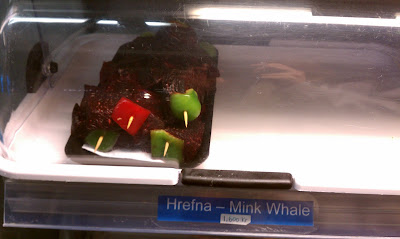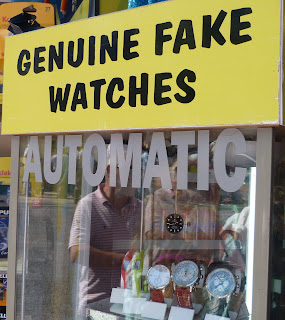 |
| THE 'REAL' DEAL: Sign at entrance to Ephesus |
HONESTY in advertising is important, which is why it was so refreshing to see the sign offering “genuine fake watches” outside a souvenir shop at the entrance to the ancient Greco-Roman city of Ephesus near Kusadasi, Turkey.
The pint of local Efes lager I had in the airside bar in Bodrum airport on the way home to Dublin was refreshing too, but the price left me feeling I’d just been mugged. How can they charge €7 for a beer that costs only €2.50 in most resorts without having the good manners to wear a mask and point a pistol? It’s a rip-off that’s had holidaymakers ranting for ages, but their outraged howls have fallen on deaf ears. The only answer, until the owners come to their senses, is to give that bar a wide berth. Or buy shares in it.
That said, the €10 entrance fee to Ephesus — one of the biggest and most remarkable outdoor museums in the world — which must be paid in local currency or by credit card is worth every cent. The place might be in ruins, but what’s left is phenomenal, as is the heat in summer, so visitors should take a litre bottle of water.
Ephesus, which was once only 2km from the bustling harbour that made it a hugely important trading port, now sits 8km inland following centuries of silt depositing by the Cayster River that created a fertile plain. Well-travelled Greek engineer and mathematician Philon of Byzantium waxed lyrical on his wax tablet, just before it melted (the temperature can hit 40C in August), after his visit in 225BC. “I have seen the walls and Hanging Gardens of ancient Babylon, the statue of Olympian Zeus, the Colossus of Rhodes, the mighty work of the high Pyramids and the tomb of Mausolus,” he wrote, “but when I saw the temple of Artemis at Ephesus rising to the clouds, all these other wonders were put in the shade.”
Fifty-odd years later, in the first recorded example of plagiarism, Greek poet Antipater of Sidon sent a postcard home saying: “I have set eyes on the wall of lofty Babylon on which is a road for chariots, and the statue of Zeus by the Alpheus, and the hanging gardens, and the Colossus of the Sun, and the huge labour of the high pyramids, and the vast tomb of Mausolus; but when I saw the house of Artemis that mounted to the clouds, those other marvels lost their brilliancy, and I said, ‘Lo, apart from Olympus, the Sun never looked on aught so grand’.” At least TV's Idiot Abroad Karl Pilkington could never be accused of being a copycat. This is the dope who looked on the same Pyramids and said: “It’s like a game of Jenga that’s got out of hand.”
 |
| HOW IT LOOKED: Temple model at Istanbul's Miniaturk |
All that remains of the Temple of Artemis, one of the Seven Wonders of the Ancient World that was built around 800BC and was four times the size of the Parthenon in Athens, is a single column of dissociated stone fragments sticking out of a swamp, though a model showing how it looked in all its white marble magnificence can be seen in the Miniaturk Park in Istanbul.
Saint Paul’s Letter to the Ephesians, written in 62AD while he was a prisoner in Rome, is one of the most popular readings at Christian marriage ceremonies. In it he says: “Each one of you must love his wife as he loves himself, and let every wife respect her husband.” There wasn’t much love or respect for Paul when he visited Ephesus in 57AD and bad-mouthed the silversmiths who earned a living churning out miniatures of the temple. A near-riot ensued, and 24,000 metalworkers and other artisans packed the amphitheatre to hear shop steward Demetrius denounce the Apostle. More recently, similar numbers have gathered there — it’s largely intact and in good condition — to see Elton John, Sting and Ray Charles perform under the stars.
But Ephesus, an hour’s coach ride from Izmir where Homer (the poet, not Simpson) was born and just 20km from the popular tourist resort of Kusadasi, is the real star, and the highlight of any visit to western Turkey.
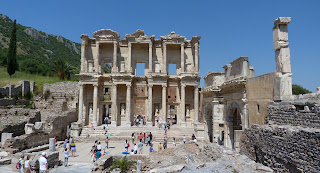 |
| FAB FACADE: Ruins of Library of Celsus at Ephesus |
The ruins include the partly-reconstructed facade of the three-storey Library of Celsus, built in honour of Roman Senator Tiberius Julius Celsus Polemaeanus (he was interred in a crypt below the entrance) by his son, Consul Gaius Julius Aquila, and completed in 135AD. The entrance was positioned facing east so that the reading rooms, which housed 12,000 scrolls, received the morning light. Only the facade remained standing after an earthquake hit the area in 262AD, and the popular tale told by tour guides is that the last words uttered by those inside when the building began to shake and collapse were: “Ssh! I’m trying to read.”
Built into the side of Mount Panayor, the huge semi-circular amphitheatre was the venue for public meetings, plays that often went on and on and yawn from early morning until midnight and gladiatorial contests involving wild animals. The acoustics are tremendous, which allowed audience members in the highest seats 30 metres above the arena to hear perfectly well the “Ouch!” and “Aow!” when a lion or a bear got the better of its tormentors.
 |
| GRAND CIRCLE: The massive amphitheatre at Ephesus |
Curetes Street, which runs from the Gate of Hercules to the Library of Celsus, was paved in marble, and ruts made by cart and chariot wheels can still be seen. I watched as several people crouched and ran their fingers in the grooves, better perhaps to get a feel of the ancient history all around. Named after the priests who kept the sacred flame, the street was lined with shops and inns, pillars, monuments and statues of notable citizens and deities and was also a main processional route. At its junction with Marble Street are the remains of the municipal brothel, where strict hygiene rules of the day obliged visitors to wash their feet before they were admitted, because you can never be too careful. Imagine going to the doctor and having to tell him: “Look, this is embarrassing. I was you-know-where the other night and I forgot to wash my feet on the way in and, well, I think I’ve picked up ... a verruca.” Etched in the pavement in Marble Street is the earliest known roadside advertisement, three drawings of a woman, a heart and a left foot directing visiting sailors to the brothel.
Nearby are the men-only public latrines, a cosy, convivial place containing benches with holes in them ranged along the walls, a channel with running water below and a pool in front where the chaps who could afford to spend a diram (there was no such thing as a free hunch, they had to pay in) would meet for a chat. In winter, wealthy citizens planning to use the latrines, which had no partitions, would send a slave in ahead of them to sit and warm the marble seat. It was from such public conveniences that we get the phrase “wrong end of the stick”. There was no toilet paper in those days; rather, sticks with sponges on the end were used, and if a patron asked his neighbour to pass the stick, he had to be careful to grab the right end.
 |
| BEST SEATS IN THE HOUSE: The latrines at Ephesus |
The remains of the two Slope Houses, currently under a protective tent while excavations continue, provide a fascinating peek into how the other half lived in Ephesus between the first and seventh centuries AD. These terraced villas containing fine examples of restored murals and mosaics behind what was a row of shops on Curetes Street close to the library, the brothel and the latrines — location, location, location — were abandoned when the silting up of the harbour adversely affected trade and their wealthy residents moved on. Ironically, several landslides that buried the houses and their contents also preserved them, and it’s worth queueing to have a look around inside.
A short drive into the mountains, with splendid views along the way of Ephesus below, is the House of the Virgin Mary, a Christian and Muslim shrine where it’s believed the mother of Christ was brought by the Apostle John after the crucifixion of her son and remained until her Assumption. Nestling in a forest on the slopes of Mount Koressos, the small stone house was discovered in October 1881 by French priest Julien Gouyet working solely from the uncannily accurate descriptions of its location and construction by a German visionary who had never been there.
Augustinian nun Anne Katherina Emmerich (1774-1824), who was beatified in October 2004 by Pope John Paul II, spent her later years bedridden in Dülmen, 40km from Dortmund, where she received a steady stream of influential visitors including, most significantly, the poet Clemens Brentano. Over the space of five years until her death, Emmerich recounted her visions of the lives of Christ and his mother to Brentano, whose notes were published in two volumes. It was these books that Gouyet used as a guide (the first, The Dolorous Passion, was director Mel Gibson’s main source of reference for his film, The Passion Of The Christ), and they led him straight to the house which is now a chapel that’s been visited by four Popes, Leo XIII in 1896, Paul VI in 1967, John Paul II in 1979 and Benedict in 2006. The spring underneath the house is reputed to have healing properties, and many crutches and walking sticks have been left behind by the lame who’ve drunk from it and, allegedly, left with a spring of another kind in their step.
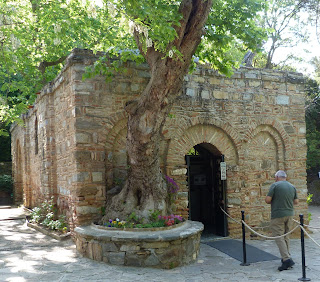 |
| SACRED SITE: The house where the Virgin Mary lived |
There’s nothing holy about the hooleys that see Kusadasi’s Bar Street hopping every night during the long holiday season. This is the thoroughfare where parents of young adults should fear to tread, lest they see what they get up to when they’re out of sight of their mammies and daddies. With all the unabashed smooching that goes on, they should rename the place Kissadasi. I vaguely remember being young and wild once, but I don’t remember teenage girls running in and out of pubs in their shifts chased by pimply-faced young bucks in those ridiculous jeans with the backside halfway down their legs. But that’s what young ones do nowadays, and good luck to them. Kusadasi ticks all the boxes as far as they’re concerned.
Away from the brashness of Bar Street, Kusadasi’s a firm family favourite, with great hotels, facilities galore and umpteen attractions nearby including waterparks and one of the best dolphin shows in Europe. I stayed a couple of nights at the exclusively-Irish Golden Day Wings Hotel after flying to Izmir, so it was a home from home, except with blistering sunshine when I visited in May. The 4-star Golden Day Wings is a five-minute walk from the waterfront and 25 minutes from Bar Street, so it’s perfectly located for those who like to laze by the pool by day and let their hair down in town at night. I had to see Bar Street, having heard so much about it, but I’d have been perfectly happy staying put in the hotel, where the in-house entertainment is a good old laugh that’ll send you to bed smiling.
 |
| KUSA-DAZZLER: View from Golden Day Wings Hotel |
 |
| STEPPED IN HISTORY: The Temple of Apollo, Didyma |
From Kusadasi I headed to Altinkum for a few nights at the 5-star all-inclusive Venosa Beach Resort and Spa, stopping en route to wander among the ruins of the ancient and enormous Temple of Apollo at Didyma, which was completed towards the end of the 8th century BC. The original temple, destroyed in 494BC by the Persians, attracted pilgrims from throughout Asia Minor and farther afield who would consult the famed oracle, a priestess who dished out advice on everything from matters of the heart to the best time to plant crops. When Alexander the Great conquered nearby Miletus in 334BC the temple was resanctified and pilgrimages resumed. However, in 303AD an over-zealous oracle told the Emperor Diocletian to persecute those pesky Christians, which he set about with fervour. When Constantine, the first Roman ruler to convert to Christianity, became Emperor in 306 he put a stop to the persecution and condemned the temple’s priests and the oracle to agonising deaths, which was only fitting for an agony aunt.
The vigorous soaping, slapping, kneading and pummelling that are part and somewhat painful parcel of a Turkish bath might be considered agony by some, but an hour after being subjected to what felt like three rounds with Mike Tyson in the spa at Venosa Beach I was tingling from head to toe and energised like never before (incidentally, the first Turkish bath in the British Isles opened in 1856 at Saint Ann’s Hydropathic Establishment in Blarney, County Cork).
Venosa Beach, where each of the 339 rooms has a sea view, is a new addition to the accommodation options available to holidaymakers in Altinkum, and it’s a beaut. Critics of all-inclusive packages can say what they like about feeling confined to one hotel, but from my experience nobody at Venosa Beach was particularly keen to wander too far from the poolside or the beach. Any wandering they did do was to the in-house restaurants, snack bars, bars, nightclub, leisure centre, gym and spa, there being neither need nor good reason to set flip-flopped foot outside one of the best holiday complexes I’ve stayed at.
 |
| WONDER-POOL: The Venosa Beach Resort and Spa |
The last (boo-hoo) of my seven nights in Turkey was spent aboard a beautiful gulet, a converted fishing boat named, appropriately, B&B, after a memorable day cruising off Bodrum. Tickets can be bought for a fun afternoon on any of umpteen gulets, or groups can charter one of these fully-crewed vessels for several days of being wined and dined and waited on hand and foot between bouts of sunbathing on deck, taking a dip in the sea and enjoying a necessary siesta. Even the worst of sleepers will have no difficulty drifting off, gently rocked by the nudging of the waves on the hull.
Bodrum is the mostly upmarket resort where Turks like to boast they’re going or have been on holiday, though it does have its noisy clubs and pubs for night owls who want to drink and dance until dawn and sleep until mid-afternoon. Those joints, however, are in one part of town while the quieter and posher bars and restaurants are in another, close to the marina with its multi-million euro ocean-going yachts. At the far end of the harbour is the 15th century Castle of Saint Peter which houses the Underwater Archaeological Museum containing artefacts recovered from wrecked ships. Several submerged wrecks dating back hundreds of years and a wealth of spectacular corals and marine life only a few minutes’ motorboat ride from the shore make the remarkably clear waters a renowned scuba diving spot.
Until the 1960s, Bodrum had for generations been a small fishing and sponge diving community quietly going about its business, but a prolonged stay by Oxford-educated Turkish intellectual Cevat Sekir during which he wrote about his sailing adventures sparked an international interest in the place. His beautifully-written book, The Blue Voyage, had yachtsmen worldwide salivating, and in no time at all they were descending on Bodrum to follow in his wake. Word quickly spread, landlubbers got to hear about it and, inevitably, tourism followed. In a satisfyingly ironic backfiring of the local tradition of farmers leaving their most fertile land to their sons and the unproductive rockier tracts nearer the sea to their daughters, it’s women who are today among Bodrum’s wealthiest citizens. When developers began looking for suitable sites on which to build hotels, apartments and villa complexes, those rocky tracts proved to be the ideal locations and — wait for it, girls — many hard-up daughters cashed-in big time on what had appeared to be worthless inheritances.
You’d need an inheritance if you wanted to buy more than a couple of drinks in that bar at Bodrum airport. As I sat there taking tiny sips from my pint so it would last the 90 minutes until the Dublin flight began boarding, I pondered on my visit earlier in the week to the carpet factory where Bill Clinton had thought nothing of paying $40,000 for an exquisite handmade silk rug. I bet he’d have thought twice about paying €7 for a beer.
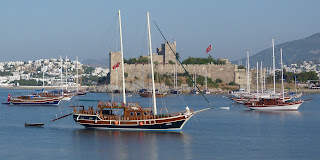 |
| BOAT-IFUL: Bodrum's harbour and its medieval castle |
GETTING THERE























